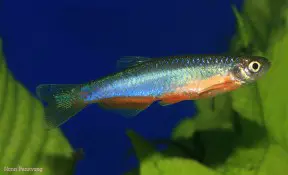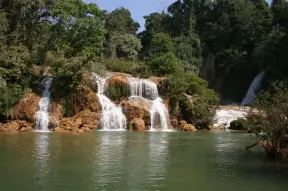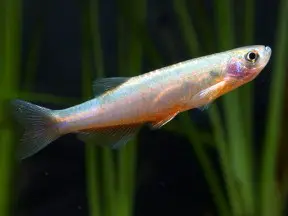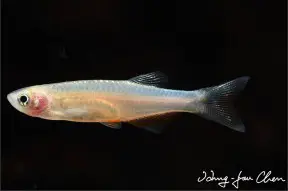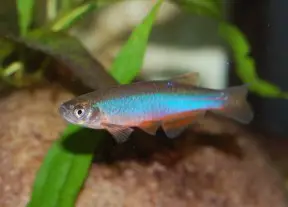Brachydanio rosea
Rosy 'Danio'
SynonymsTop ↑
Danio roseus Fang & Kottelat, 2000
Etymology
Brachydanio: from the Ancient Greek βραχύς (brakhús), meaning ‘short’, and Dhani, a Bengalese vernacular term for small, minnow-like cyprinids.
roseus: from the Latin roseus, meaning ‘rosy, pink’, in reference to the colour pattern in nuptial males.
Classification
Order: Cypriniformes Family: Cyprinidae
Distribution
Described from the Mekong River basin in Nong Khai and Chiang Rai Provinces, northern Thailand, and Louangphabang Province, northern Laos but now known to occur further north having been recorded at several localities in northern Myanmar.
Type locality is ‘Nam Tok Than Thip, 3 kilometers off main road at Ban Tad Some, 13 kilometers west of Sam Kon on road Loei – Nong Khai’.
Habitat
Most commonly found in small, well-oxygenated, running streams under forest cover but has also been collected from backwaters of larger rivers, and there exists a single record from the main Mekong channel itself.
Such habitats are typically seasonal in nature and water depth, flow, temperature and chemical characters vary depending on time of year.
In images the Nam Khwe River, Myanmar contains quite shallow, turbid, moderately fast-flowing water; the substrate is composed of variably-sized boulders with some relatively little streamside vegetation.
Sympatric species include Brachydanio albolineata plus unidentified members of Barilius and Opsarius. In the larger Nam Lawe River, also Myanmar, it lives alongside Badis ruber, Colisa labiosa, Lepidocephalichthys berdmorei and an unidentified Brachydanio species.
Maximum Standard Length
50 – 55 mm.
Aquarium SizeTop ↑
Base dimensions of 90 ∗ 30 cm or equivalent should be the smallest considered.
Maintenance
Looks particularly effective in a heavily-planted arrangement with a darker substrate, and may appear paler in sparsely-decorated set-ups.
We suggest maintaining it in a well-planted aquarium or set-up designed to resemble a flowing river or stream, with a substrate of variably-sized rocks and gravel and some large water-worn boulders.
Additional powerhead(s) or filter outlets can be used to provide flow but torrent-like conditions should be avoided since small danionins tend to occupy calmer stretches and marginal zones in nature.
Driftwood roots, branches and aquatic plants, with hardy genera such as Microsorum, Bolbitis or Anubias ideal since they can be grown attached to the décor, can also be added.
The aquarium must have a very tightly-fitting cover as members of this genus are accomplished jumpers and can fit through surprisingly small gaps.
Water Conditions
Temperature: 18 – 25 °C
pH: 6.0 – 7.5
Hardness: 36 – 268 ppm
Diet
Almost certain to prey chiefly on insects and their larvae in nature. In the aquarium it’s largely an unfussy feeder and will accept most foods.
A good quality dried product or two can be used as the staple diet but this should be supplemented with regular meals of small live and frozen fare such as bloodworm, Daphnia, Artemia, etc., for the fish to show the best colouration and conditioning.
Behaviour and CompatibilityTop ↑
This species is very peaceful indeed making it an ideal resident of the well-furnished community tank.
Since it places no special demands in terms of water chemistry it can be combined with many of the most popular fish in the hobby including other small cyprinids as well as tetras, livebearers, rainbowfish, anabantoids, catfish and loaches.
A community based around species from one of its native countries or river basins would also make an interesting project with numerous sympatric species available in the trade.
It’s a schooling species by nature and should be kept in a group of at least 8-10 specimens.
Maintaining it in decent numbers will not only make the fish less nervous but result in a more effective, natural-looking display while males will also exhibit their best colours as they compete with one other for female attention.
Sexual Dimorphism
Females tend to grow larger than males and are generally deeper-bodied, more so when gravid.
Reproduction
Like many small cyprinids this species is an egg-scattering spawner that exhibits no parental care.
That is to say when the fish are in good condition they will spawn often and in a densely-planted, mature aquarium it is possible that small numbers of fry may start to appear without human intervention.
However if you want to increase the yield of fry a slightly more controlled approach is required.
The adult group can still be conditioned together but one or more smaller, say 20-30 litre containers should also be set up and half-filled with water.
These should be very dimly lit and the base covered with some kind of mesh of a large enough grade so that the eggs can fall through it but small enough so that the adults cannot reach them.
The widely available plastic ‘grass’-type matting can also be used and works very well; alternatively filling much of the tank with Java moss or other fine-leaved plant can also yield good results.
The water itself should be of slightly acidic to neutral pH with a temperature towards the upper end of the range suggested above.
A small power filter can be added initially and this should be positioned so that the flow is directed down the full length of the tank.
When the adult fish are well-conditioned and the females appear full of eggs one or two pairs should then be introduced to each container.
Spawning can be initiated by adding small amounts of cool water every few hours in such a way that the tank is gradually topped up and feeding small amounts of live and frozen foods.
The pair should spawn the following morning. The easiest and quickest way to tell is simply to look at the female since if the fish have spawned she will be noticeably slimmer.
The adults will eat any eggs they find and are best removed after a couple of days at which point the power filter should be switched for a mature sponge-type unit in order to avoid fry being sucked into the mechanism.
Incubation is temperature-dependant to an extent but usually takes between 24 and 36 hours with the young free-swimming a few days later.
Initial food should be Paramecium or a proprietary dry food of sufficiently small (5-50 micron diameter) grade, introducing Artemia nauplii, microworm etc. once the fry are large enough to accept them.
NotesTop ↑
B. rosea is a relatively recent addition to the aquarium trade but has proved very popular since it’s colourful, hardy and usually quite cheap making it ideal for beginners. It’s sometimes sold as ‘purple passion danio’.
It’s very similar to B. albolineata sensu stricto but differs in several characters, notably the relatively slimmer body, shorter rostral barbels and lack of dark stripes on the posterior half of the body.
Breeders in eastern Europe have successfully crossed B. albolineata and B. rosea, and many of the fishes currently seen in the hobby are thought to be hybrids. If you want to avoid these beware of fish with a very cheap price tag that show a high proportion of both powdery-blue colouration on the body and red in the unpaired fins.
In recent years it’s become commonplace to refer to the stripes on the body and fins of danionins as follows:
– P stripe: or “pigment stripe” is the central, dark, lateral stripe on the body which extends into the caudal-fin in some species. Stripes above it are numbered P+1, P+2, etc. and those beneath P-1, P-2, P-3.
– A stripe: the central stripe on the anal-fin; the proximal stripe (above it) is A+1 and the distal stripe (beneath) A-1.
– D stripe: The submarginal dorsal-fin stripe.
Following Fang (2003) Brachydanio spp. are characterised by the presence of an A stripe on the anal-fin and two or more P stripes on the caudal, plus some internal characteristics such as enlarged nasal lamellae.
The genus has undergone some significant taxonomic reshuffling in recent years following the publication of a series of phylogenetic studies.
Older, molecular, phylogenies tended to agree that it represented a monophyletic group consisting of two major clades; the ‘Danio devario‘ group containing the larger, deeper-bodied species and the ‘D. rerio‘ clade comprising the smaller, slimmer fish.
However in 2003 Fang conducted a more detailed study based on morphological characters which included members of other related genera, and the results suggested for the first time that the genus Danio as previously considered represents a polyphyletic grouping, i.e., not all members derived from a single common ancestor.
The genus name Devario was suggested for the larger species with Danio being applied only to the smaller fish (with the exception of the type species, D. dangila which can grow to around 89 mm SL). Recent molecular studies by Mayden et al. (2007) and Fang et al. (2009) resulted in further changes, with the latter study considering the genus Danio to be composed of three subclades. These were subsequently split into distinct genera by Kottelat (2013), as follows:
The former species D. erythromicron, D. margaritatus, D. choprae and D. flagrans are grouped together in the revalidated genus Celestichthys Roberts, 2007. These exhibit unique body patterning consisting of vertical bars (C. erythromicron, C. choprae, C. flagrans) or light spots (C. margaritatus) and possess either very short barbels or none at all.
The genus Danio contains only the type species, D. dangila, separated on the basis of its larger size and the shape of the caudal-fin, which in adults is only slightly emarginate or even truncate in shape, a feature it shares only with Tinca tinca (the common tench) among other cyprinids.
The remaining species, of which B. rerio is thought to be the most ancient, are included in the revalidated genus Brachydanio Weber & de Beaufort, 1916.
References
- Fang, F. and M. Kottelat, 2000 - Ichthyological Exploration of Freshwaters 11(2): 149-154
Danio roseus, a new species from the Mekong basin in northeastern Thailand and northwestern Laos (Teleostei: Cyprinidae). - Conway, K. W., W.-J. Chen and R. L. Mayden, 2008 - Zootaxa 1686: 1-28
The 'Celestial Pearl danio' is a miniature Danio (s.s) (Ostariophysi: Cyprinidae): evidence from morphology and molecules. - Fang, F., 2003 - Copeia 2003(4): 714-728
Phylogenetic Analysis of the Asian Cyprinid Genus Danio (Teleostei, Cyprinidae). - Fang, F., M. Norén, T. Y. Liao, M. Källersjö and S. O. Kullander, 2009 - Zoologica Scripta 38(1): 1-20
Molecular phylogenetic interrelationships of the south Asian cyprinid genera Danio, Devario and Microrasbora (Teleostei, Cyprinidae, Danioninae). - Kottelat, M., 2013 - The Raffles Bulletin of Zoology Supplement 27: 1-663
The fishes of the inland waters of southeast Asia: a catalogue and core bibiography of the fishes known to occur in freshwaters, mangroves and estuaries. - Mayden, R. L., K. L. Tang, K. W. Conway, J. Freyhof, S. Chamberlain, M. Haskins, L. Schneider, M. Sudkamp, R. M. Wood, M. Agnew, A. Bufalino, Z. Sulaiman, M. Miya, K. Saitoh, S. He, 2007 - Journal of Experimental Zoology, Molecular Development and Evolution 308B: 642–654
Phylogenetic relationships of Danio within the order Cypriniformes: a framework for comparative and evolutionary studies of a model species. - Roberts, T. R., 2007 - Raffles Bulletin of Zoology 55(1): 131-140
The 'Celestial Pearl Danio', a new genus and species of colourful minute cyprinid fish from Myanmar (Pisces: Cypriniformes).
